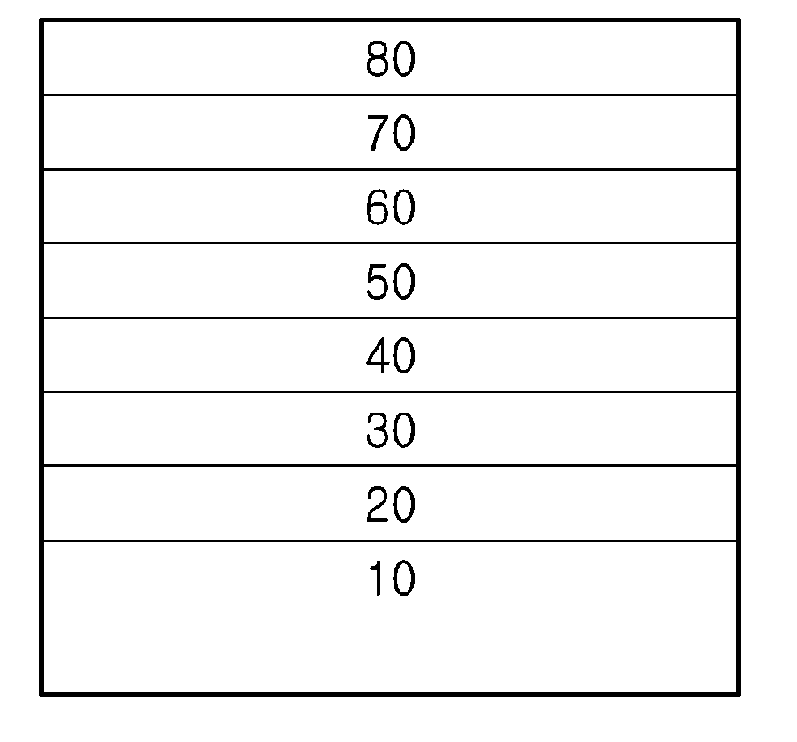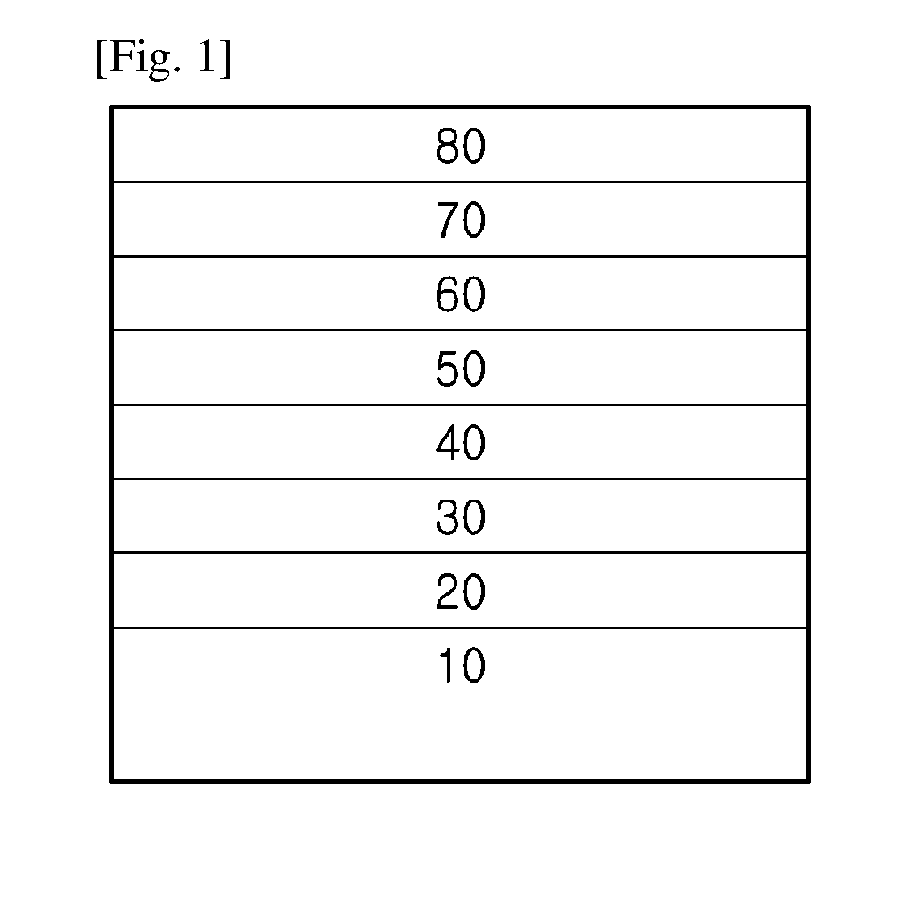Organic light emitting compound and organic light emitting device comprising the same
a light-emitting compound and organic technology, applied in the direction of luminescent compositions, organic chemistry, luminescent compositions, etc., can solve the problems that the power efficiency of organic electroluminescence devices using balq and cbp as phosphorescent host materials is not significant, and achieves improved luminous efficiency and life characteristics, high power efficiency
- Summary
- Abstract
- Description
- Claims
- Application Information
AI Technical Summary
Benefits of technology
Problems solved by technology
Method used
Image
Examples
synthesis example 1
Synthesis of Compound 2
[0042][Reaction 1-1] Synthesis of Intermediate 1-a
[0043]1-Nitronaphthalene (97 g, 0.56 mol), methyl cyanoacetate (166.5 g, 1.68 mol), potassium cyanide (40.1 g, 0.62 mol), potassium hydroxide (62.9 g, 1.12 mol), and 970 mL of dimethylformamide were mixed and stirred at 60° C. for 12 h. The mixture was concentrated under reduced pressure to remove the solvent, and then 500 mL of a 10% aqueous solution of sodium hydroxide was added thereto. The resulting mixture was refluxed for about 1 h. The reaction mixture was extracted with ethyl acetate, separated by column chromatography, and recrystallized from toluene and heptane, affording 50.8 g of Intermediate 1-a (yield 54%).
[0044][Reaction 1-2] Synthesis of Intermediate 1-b
[0045]Intermediate 1-a (25.0 g, 149 mmol) synthesized in Reaction 1-1 was dissolved and stirred in 200 mL of tetrahydrofuran. To the solution was added dropwise phenylmagnesium bromide (3.0 M in Et2O) (104 mL, 313 mmol). The mixture was refluxed ...
synthesis example 2
Synthesis of Compound 8
[0057][Reaction 2-1] Synthesis of Intermediate 2-a
[0058]Intermediate 2-a (yield 45%) was synthesized in the same manner as in Reactions 1-2 and 1-3, except that pentadeuterophenylmagnesium bromide was used instead of phenylmagnesium bromide in Reaction 1-2.
[0059][Reaction 2-2] Synthesis of Intermediate 2-b
[0060]Intermediate 2-b (yield 86%) was synthesized in the same manner as in Reaction 1-5, except that 3-bromo-9H-carbazole was used instead of 4-bromo-9H-carbazole.
[0061][Reaction 2-3] Synthesis of Intermediate 2-c
[0062]Intermediate 2-c (yield 73%) was synthesized in the same manner as in Reaction 1-7, except that Intermediate 2-b synthesized in Reaction 2-2 and 9H-carbazol-3-ylboronic acid were used instead of Intermediate 1-d and Intermediate 1-f, respectively.
[0063][Reaction 2-4] Synthesis of Compound 8
[0064]Compound 8 (yield 32%) was synthesized in the same manner as in Reaction 1-4, except that Intermediate 2-c synthesized in Reaction 2-3 and Intermediat...
synthesis example 3
Synthesis of Compound 26
[0066][Reaction 3-1] Synthesis of Intermediate 3-a
[0067]Intermediate 3-a (yield 48%) was synthesized in the same manner as in Reactions 1-1 to 1-3, except that heptadeuteronitronaphthalene and 4-biphenylmagnesium bromide were used instead of 1-nitronaphthalene in Reaction 1-1 and phenylmagnesium bromide in Reaction 1-2, respectively.
[0068][Reaction 3-2] Synthesis of Intermediate 3-b
[0069]2-Naphthol (20 g, 0.14 mol), sodium bisulfite (28.8 g, 0.28 mol), and 4-bromophenylhydrazine (31.2 mL, 0.17 mol) were stirred in 160 mL of distilled water at 120° C. for 12 h. To the mixture was added an aqueous solution of hydrochloric acid. After stirring at 100° C. for about 1 h, the reaction mixture was extracted with dichloromethane and separated by column chromatography, affording Intermediate 3-b (yield 22%).
[0070][Reaction 3-3] Synthesis of Intermediate 3-c
[0071]Intermediate 3-c (yield 64%) was synthesized in the same manner as in Reactions 1-5 and 1-6, except that In...
PUM
| Property | Measurement | Unit |
|---|---|---|
| temperature | aaaaa | aaaaa |
| temperature | aaaaa | aaaaa |
| pressure | aaaaa | aaaaa |
Abstract
Description
Claims
Application Information
 Login to View More
Login to View More - R&D
- Intellectual Property
- Life Sciences
- Materials
- Tech Scout
- Unparalleled Data Quality
- Higher Quality Content
- 60% Fewer Hallucinations
Browse by: Latest US Patents, China's latest patents, Technical Efficacy Thesaurus, Application Domain, Technology Topic, Popular Technical Reports.
© 2025 PatSnap. All rights reserved.Legal|Privacy policy|Modern Slavery Act Transparency Statement|Sitemap|About US| Contact US: help@patsnap.com



